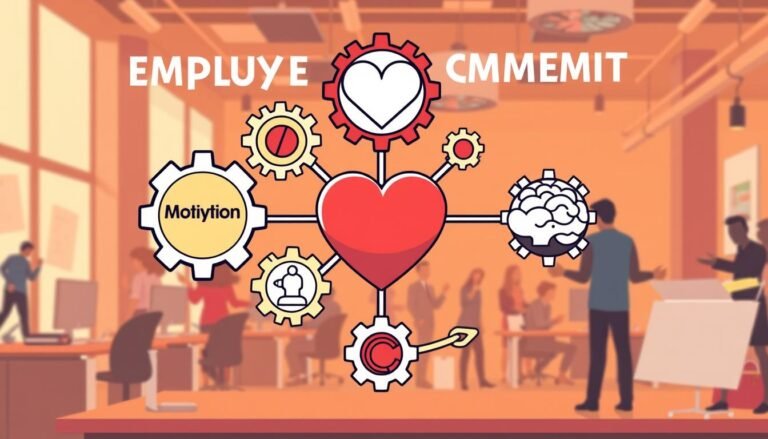Compassion Fatigue in Professional Settings
In today’s fast-paced work environments, emotional burnout is a big issue. People in high-stress jobs often face vicarious trauma, affecting their mental health at work. Compassion fatigue, a special kind of burnout, hits those in helping roles like healthcare workers, therapists, and first responders.
This condition is more than just job stress. It’s deep exhaustion and emotional pain. Unlike regular burnout, those with compassion fatigue keep giving to others, finding it hard to balance empathy and objectivity. The demands of today’s workplaces, along with less control, can make it worse.
Recent data shows how big this problem is. During the COVID-19 pandemic, over 100,000 healthcare provider deaths were reported between January 2020 and May 2021. This sad number shows the extreme pressure on those in caring jobs. The pandemic has made the risks of compassion fatigue clear, affecting how well patients are cared for.
Key Takeaways
- Compassion fatigue affects professionals in helping roles
- It’s characterized by deep exhaustion and emotional pain
- High-stress environments increase the risk of compassion fatigue
- The COVID-19 pandemic has heightened the risk for healthcare providers
- Recognizing early signs is crucial for prevention and treatment
Understanding Compassion Fatigue in Professional Settings
Compassion fatigue is common in high-stress jobs. It’s more than just burnout. It affects those who care for others, causing stress and less empathy.
Definition and Core Concepts
Compassion fatigue is a mix of burnout and secondary traumatic stress. It happens when you’re always exposed to others’ pain. It affects many, like healthcare workers and counselors.
The Psychology Behind Compassion Fatigue
Long-term stress drains you emotionally. This leads to physical and mental exhaustion. Signs include:
- Feeling drained in every cell
- Anger and irritability
- Difficulty thinking clearly
- Increased health issues
Distinguishing from Regular Burnout
Compassion fatigue is different from regular burnout. It affects your ability to empathize. This can make you detached and less caring at work.
| Compassion Fatigue | Regular Burnout |
|---|---|
| Reduced empathy | General job dissatisfaction |
| Secondary traumatic stress | Work-related stress |
| Impacts ability to care | Affects overall motivation |
It’s key for those in caring roles to understand compassion fatigue. Recognizing early signs helps prevent emotional exhaustion. This way, we can keep quality care and job satisfaction in tough fields.
Early Warning Signs and Symptoms
It’s important to spot the early signs of compassion fatigue to keep work environments healthy. As more jobs face this issue, knowing how to recognize it is key.
Physical Manifestations
The body often shows signs of stress before we realize it. Look out for headaches, stomach problems, and trouble sleeping. These signs can really affect how well you do at work.
Emotional Indicators
Changes in how you feel are big signs of compassion fatigue. You might get angrier, feel cynical, or find it hard to care about others. These feelings can make it tough to get along with colleagues and talk well at work.
Behavioral Changes
Behavior changes are also signs of compassion fatigue. You might pull away from people, work less well, or find it hard to make decisions. These small changes can really affect how you do your job and how well your team works together.
| Warning Sign Category | Examples | Impact on Work |
|---|---|---|
| Physical | Headaches, Sleep disturbances | Reduced concentration, Fatigue |
| Emotional | Irritability, Decreased empathy | Strained relationships, Poor communication |
| Behavioral | Social isolation, Indecisiveness | Lowered productivity, Team conflicts |
Spotting these signs early is crucial for a healthy work place. By acting fast, companies can help their employees stay strong and avoid more serious stress problems.
Impact on Professional Performance
Compassion fatigue greatly affects workplace productivity and professional skills. Healthcare workers, first responders, and social service professionals are especially at risk. The COVID-19 pandemic has made things worse, leading to mental health issues like anxiety and depression.
Patient care quality often drops as professionals deal with compassion fatigue. Almost 7% of those working with traumatized people show signs of PTSD. This can cause poor decision-making and more medical errors.
The effects go beyond individual performance. Strained relationships with colleagues and clients can hurt trust and success. Some professionals might use unhealthy coping methods, making quality care harder to provide.
| Professional Group | Compassion Fatigue Rate | Key Impact |
|---|---|---|
| Nurses | Over 50% | Decreased patient care quality |
| COVID-19 Unit Staff | Significantly high | Increased mental health concerns |
| Healthcare Practitioners | Average to high levels | Reduced professional efficacy |
To fight this growing problem, hospitals and medical institutions need to offer training on compassion fatigue. Experienced doctors who focus on mental health can inspire new professionals. This could lead to better workplace productivity and patient care in the future.
Risk Factors in Modern Workplace
The modern workplace is filled with risks for compassion fatigue, especially in high-stress areas like healthcare. Stress at work has grown, leading to more work and less time. A study found that 75.88% of obstetrics and gynaecology nurses face moderate to high compassion fatigue.
High-Stress Environments
Healthcare, especially during crises like the COVID-19 pandemic, increases the risk of compassion fatigue. Nurses working with vulnerable groups, like women or children, for long periods are more at risk. Research shows that nurses with 4-16 years of experience in obstetrics and gynaecology are more likely to experience compassion fatigue.
Lack of Support Systems
Not having enough support at work makes compassion fatigue worse. A study found that social support helps reduce compassion fatigue. Factors like autonomy, trust, and work-life balance also play a big role in how much compassion fatigue nurses experience.
Personal Vulnerability Factors
Being resilient is key to fighting compassion fatigue. Young female nurses, aged 18-25 with bachelor’s degrees and 1-3 years of service, face higher levels of compassion fatigue in intensive care units. Emotional labor is strongly linked to compassion fatigue in nurses.
| Risk Factor | Impact | Prevalence |
|---|---|---|
| High Emotional Labor | Medical Errors | 23% of nurses |
| Burnout | Resource Depletion | Widespread |
| Work-Life Imbalance | Increased Compassion Fatigue | Significant |
The Role of Organizational Culture
Workplace culture is key in fighting compassion fatigue. A study shows 35-43% of workers face this issue, showing it’s common across many fields. Companies can greatly improve employee happiness with the right culture and policies.
Workplaces that care about their employees can lower the risk of compassion fatigue. Studies show strong support cultures help people avoid this burnout. This shows how vital a positive work culture is.
On the flip side, workplaces with unclear values or too much change see more burnout. This means clear values are good for mental health. Adding support policies, training, and mental health resources can cut down on burnout.
“Organizational support in the form of social networks and peer support has been demonstrated to reduce the risk of compassion fatigue through building cohesive teams, promoting relational coordination, and hosting regular check-ins and debriefing sessions.”
Steps like reviewing workloads and improving processes can help. Companies with Employee Assistance Programs (EAPs) offer great support. They help with fitness, nutrition, and sleep, too.
By focusing on a supportive culture and employee well-being, companies can make a better work place. This not only reduces burnout but also boosts job happiness and performance.
Assessment and Measurement Tools
Spotting compassion fatigue early is key for keeping mental health strong in work settings. Many tools help with this, making it easier for companies to support their employees.
Professional Quality of Life Scale
The Professional Quality of Life Scale (ProQOL) is a popular tool for self-checks. It looks at how much joy you get from work, burnout, and compassion fatigue. This 30-question test helps people see how their job affects them.
Self-Assessment Techniques
Checking in with yourself regularly is important for catching signs early. Look out for losing interest in work, feeling more irritable, and struggling to cope. Keeping a journal can help track these signs over time.
Clinical Evaluation Methods
Getting a deeper look from a mental health expert is another step. They might use interviews and psychological tests. The Secondary Traumatic Stress Scale (STSS) is one tool used to check for stress caused by helping others.
| Assessment Tool | Focus Areas | Reliability |
|---|---|---|
| ProQOL | Compassion satisfaction, burnout, compassion fatigue | 0.87, 0.72, 0.80 |
| STSS | Intrusion, Avoidance, Arousal | 0.93, 0.80, 0.87 |
| CF-Short Scale | Compassion fatigue | High internal consistency |
These tools are key for keeping employees well. They give insights into work life, helping to act fast and support workers.
Prevention Strategies and Self-Care
Self-care is key to avoiding compassion fatigue for professionals. Mindfulness and a good work-life balance help build resilience and lower stress.
Mindfulness Practices
Mindfulness helps manage stress and boosts emotional health. Activities like meditation, deep breathing, and body scans increase awareness and reduce anxiety. Adding these to your daily routine keeps you focused and grounded.
Boundary Setting
It’s important to set clear boundaries between work and personal life. This means setting work hours, not checking work emails outside work, and saying no to extra tasks when needed. Good boundaries prevent burnout and keep a healthy balance.
Work-Life Balance Techniques
Keeping a balance between work and life is crucial to avoid compassion fatigue. Activities like exercise, hobbies, and socializing outside work improve well-being. Companies can help by offering mental health resources and encouraging time off.
| Self-Care Strategy | Benefits | Implementation Tips |
|---|---|---|
| Mindfulness Meditation | Reduces stress, improves focus | Start with 5 minutes daily, use guided apps |
| Regular Exercise | Boosts mood, increases energy | Aim for 30 minutes, 5 days a week |
| Healthy Sleep Habits | Enhances recovery, improves cognition | Maintain consistent sleep schedule, limit screen time |
By using these self-care methods, professionals can fight compassion fatigue and stay well in stressful jobs.
Treatment and Recovery Approaches
Dealing with compassion fatigue needs a mix of strategies. Getting mental health support is key. Professional counseling helps people deal with their feelings and learn how to cope.
Group therapy lets people connect with others who face similar issues. It builds a sense of community and shared understanding.
Building resilience is important for recovery. This includes learning stress management, improving emotional intelligence, and having strong support networks. Mindfulness and physical activity, like the CDC suggests, also help.
Organizations have a big role in helping recovery. They can offer mental health resources, flexible work, and a healthy work environment. Studies show these efforts improve employee well-being and lower burnout.
Recovery is a journey, and it’s okay to ask for help. With the right support, you can beat compassion fatigue and find joy again in caring jobs. Clear Behavioral Health in Los Angeles offers various programs, including in Redondo Beach and Pasadena, to support those struggling.
Source Links
- Compassion Fatigue: Symptoms to Look For
- Compassion fatigue in healthcare providers: a scoping review
- Moving from compassion fatigue to compassion resilience Part 4: Signs and consequences of compassion fatigue
- Recognizing and Addressing Compassion Fatigue: Effective Strategies for Management – The Honor Movement Foundation
- Overcoming Compassion Fatigue
- Compassion Fatigue: Watch for These Warning Signs | Banner
- Are you experiencing compassion fatigue?
- Compassion Fatigue and Burnout – League of Minnesota Cities
- Compassion Fatigue: What to Do When Care Becomes Overwhelming
- From Empathy to Compassion Fatigue: A Narrative Review of Implications in Healthcare
- Factors associated with compassion fatigue and compassion satisfaction in obstetrics and gynaecology nurses: A cross‐sectional study
- How are compassion fatigue, burnout, and compassion satisfaction affected by quality of working life? Findings from a survey of mental health staff in Italy – BMC Health Services Research
- Am I Just Burned Out or is it Compassion Fatigue?
- The Relationship between Compassion Fatigue and Organizational Culture
- Moving from compassion fatigue to compassion resilience Part 6: Building organizational resilience
- How to Self-Assess Compassion Fatigue
- Measuring Compassion Fatigue – Clinical Social Work Journal
- Building Compassion Fatigue Resilience: Awareness, Prevention, and Intervention for Pre-Professionals and Current Practitioners
- Preventing Compassion Fatigue: Self-Care Tips for People in the Helping Industry
- Compassion Fatigue and Self-care Resources for Crisis Counselors
- Navigating Compassion Fatigue: Causes, Signs, Effects, and the Path to Recovery – Heather Hayes & Associates
- How to Cope with Compassion Fatigue | Clear Behavioral Health
- What Is Compassion Fatigue? 9 Coping Tips For Caregivers








